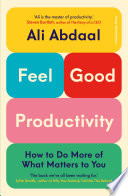

Feel-Good Productivity emphasizes that emotional well-being is crucial to achieving high levels of productivity. Traditional productivity methods often overlook the mental and emotional state of individuals, leading to burnout and decreased efficiency. The book argues that when people feel good—emotionally and mentally—they are more likely to engage deeply with their work, leading to better outcomes. This idea is supported by research that links positive emotions to enhanced creativity, problem-solving skills, and overall job satisfaction. By prioritizing emotional health, individuals can create a more sustainable and enjoyable work environment that fosters productivity without sacrificing personal happiness.
Continue readingThe book challenges conventional definitions of success that often equate it with long hours and relentless hustle. Instead, it advocates for a more holistic view of success that includes personal fulfillment, work-life balance, and emotional satisfaction. This redefinition encourages readers to reflect on their own values and what success means to them personally, rather than adhering to societal expectations. By setting personalized goals that align with their values, individuals can pursue a path that feels rewarding and fulfilling, rather than merely productive in the traditional sense.
Continue readingFeel-Good Productivity introduces mindfulness as a key practice for enhancing productivity. The book explains that being present in the moment allows individuals to focus better, reduce stress, and improve their overall performance. Mindfulness techniques, such as meditation and conscious breathing, are presented as tools to help individuals cultivate awareness and manage distractions. By integrating mindfulness into their daily routines, readers can enhance their ability to concentrate on tasks, leading to increased productivity without the negative side effects of stress and anxiety.
Continue readingThe book discusses how physical and emotional environments significantly impact productivity levels. A cluttered or chaotic workspace can lead to feelings of overwhelm and distraction, while a well-organized and aesthetically pleasing environment can promote focus and creativity. Feel-Good Productivity encourages readers to create spaces that inspire them and align with their work styles. This includes decluttering, personalizing workspaces, and ensuring that the environment supports their emotional well-being. The idea is that a conducive environment can enhance productivity naturally, making work feel less like a chore and more like an enjoyable activity.
Continue readingOne of the critical lessons in Feel-Good Productivity is the importance of setting boundaries to protect one's time and energy. The book emphasizes that overcommitting and failing to say no can lead to burnout and decreased productivity. By learning to establish clear boundaries, individuals can prioritize their tasks and focus on what truly matters to them. This practice not only enhances productivity but also contributes to emotional well-being, as it allows individuals to engage in work that aligns with their values and goals, rather than spreading themselves too thin.
Continue readingFeel-Good Productivity advocates for the cultivation of a growth mindset, which is the belief that abilities and intelligence can be developed through dedication and hard work. This mindset fosters resilience, encourages continuous learning, and promotes a positive approach to challenges. The book provides strategies for developing a growth mindset, such as embracing failures as learning opportunities and seeking feedback. By adopting this perspective, individuals can enhance their productivity by viewing obstacles as chances for growth rather than setbacks.
Continue readingThe final key idea presented in the book is the significance of community and collaboration in enhancing productivity. Feel-Good Productivity highlights that working in isolation can lead to feelings of loneliness and decreased motivation. Conversely, engaging with a supportive community can provide encouragement, accountability, and inspiration. The book encourages readers to seek out collaborative opportunities and build relationships that foster a sense of belonging. By leveraging the power of community, individuals can enhance their productivity and overall well-being.
Continue reading